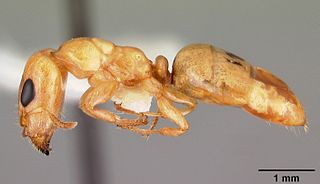
Ponerinae, the ponerine ants, is a subfamily of ants in the Poneromorph subfamilies group, with about 1,600 species in 47 extant genera, including Dinoponera gigantea - one of the world's largest species of ant. Mated workers have replaced the queen as the functional egg-layers in several species of ponerine ants. In such queenless species, the reproductive status of workers can only be determined through ovarian dissections.

Dolichoderinae is a subfamily of ants, which includes species such as the Argentine ant, the erratic ant, the odorous house ant, and the cone ant. The subfamily presents a great diversity of species throughout the world, distributed in different biogeographic realms, from the Palearctic, Nearctic, Afrotropical region and Malaysia, to the Middle East, Australian, and Neotropical regions.

Pachycondyla is a ponerine genus of ants found in the Neotropics.

Dolichoderus is a genus of ants found worldwide.

Gesomyrmex is a genus of ants in the subfamily Formicinae. The genus contains six extant species, known from the Indomalayan realm, and nine fossil species. Of the extant species, four are known only from workers and two only from females. The extinct species "G. expectans" and "Gesomyrmex miegi", formerly placed in the genus, were excluded by Dlussky et al.., 2009.
Pristomyrmex rasnitsyni is an extinct species of ant in the genus Pristomyrmex. The species is known from a single Late Eocene fossil which was found in Europe.

Emplastus is an extinct morphogenus of ants in the subfamily Dolichoderinae, known from fossils found in Asia and Europe. The genus contains twelve species described from sites in England, Eastern Europe and Far Eastern Russia.

Casaleia is an extinct genus of ants in the formicid subfamily Amblyoponinae described by Pagliano & Scaramozzino in 1990 from fossils found in Europe. The genus contains four species dating from the Eocene to Miocene, Casaleia eocenica, Casaleia inversa, Casaleia longiventris, Casaleia orientalis.
Dolichoderus brevipalpis is an extinct species of ant in the genus Dolichoderus. Described by Dlussky in 2008, the ant is from the Eocene epoch, being discovered in the Baltic Amber.

Dolichoderus longipilosus is an extinct species of Eocene ant in the genus Dolichoderus. It was described by Dlussky in 2002, and the fossils of the species are only known from a fossilised worker that was found in the Baltic amber.

Dolichoderus nanus is an extinct species of Eocene ant in the genus Dolichoderus. Described by Dlussky in 2002, a fossilised worker was discovered in the Baltic amber.
Dolichoderus perkovskyi is an extinct species of Eocene ant in the genus Dolichoderus. Described by Dlussky in 2008, fossils of the species have been found in multiple ambers, notably the Rovno amber and the Scandinavian amber.
Dolichoderus pilipes is an extinct species of Eocene ant in the genus Dolichoderus. Described by Dlussky in 2008, fossils of the species have been found in multiple ambers, notably the Rovno amber and the Scandinavian amber.
Dolichoderus polessus is an extinct species of Eocene ant in the genus Dolichoderus. Described by Dlussky in 2002, a fossilised worker was discovered in the Rivne amber.
Dolichoderus polonicus is an extinct species of Eocene ant in the genus Dolichoderus. Described by Dlussky in 2002, a fossilised worker was discovered in the Baltic amber.

Dolichoderus punctatus is an extinct species of Eocene ant in the genus Dolichoderus. Described by Dlussky in 2008, fossils of the species were found in the Baltic Amber.
Dolichoderus robustus is an extinct species of Eocene ant in the genus Dolichoderus. Described by Dlussky in 2002, a fossilised worker was discovered in the Rivne amber.
Dolichoderus pinguis is an extinct species of formicid in the ant subfamily Dolichoderinae known from a fossil found in Asia. The species is one of a number in the genus described from fossils.
Pachycondyla oligocenica is an extinct species of formicid in the ant subfamily Ponerinae known from a fossil found in eastern Asia.
Klondikia is an extinct hymenopteran genus in the ant family Formicidae with a single described species Klondikia whiteae. The species is solely known from the Early Eocene sediments exposed in northeast Washington state, United States. The genus is currently not placed into any ant subfamily, being treated as incertae sedis.










